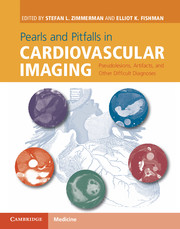 Pearls and Pitfalls in Cardiovascular Imaging
Pearls and Pitfalls in Cardiovascular Imaging Book contents
- Frontmatter
- Contents
- List of contributors
- Preface
- Section 1 Cardiac pseudotumors and other challenging diagnoses
- Section 2 Cardiac aneurysms and diverticula
- Section 3 Anatomic variants and congenital lesions
- Section 4 Coronary arteries
- Section 5 Pulmonary arteries
- Section 6 Cardiovascular MRI artifacts
- Case 47 Inappropriate inversion time selection for late gadolinium enhancement imaging
- Case 48 Pseudothrombus on dark blood images
- Case 49 Gibbs ringing artifact
- Case 50 Aliasing artifact in phase-contrast cardiac MR
- Case 51 Pseudostenoses on MR angiography from susceptibility artifact
- Case 52 Pseudostenosis on time-of-flight magnetic resonance angiography
- Case 53 Maki effect
- Section 7 Acute aorta and aortic aneurysms
- Section 8 Post-operative aorta
- Section 9 Mesenteric vascular
- Section 10 Peripheral vascular
- Section 11 Veins
- Index
- References
Case 49 - Gibbs ringing artifact
from Section 6 - Cardiovascular MRI artifacts
Published online by Cambridge University Press: 05 June 2015
- Frontmatter
- Contents
- List of contributors
- Preface
- Section 1 Cardiac pseudotumors and other challenging diagnoses
- Section 2 Cardiac aneurysms and diverticula
- Section 3 Anatomic variants and congenital lesions
- Section 4 Coronary arteries
- Section 5 Pulmonary arteries
- Section 6 Cardiovascular MRI artifacts
- Case 47 Inappropriate inversion time selection for late gadolinium enhancement imaging
- Case 48 Pseudothrombus on dark blood images
- Case 49 Gibbs ringing artifact
- Case 50 Aliasing artifact in phase-contrast cardiac MR
- Case 51 Pseudostenoses on MR angiography from susceptibility artifact
- Case 52 Pseudostenosis on time-of-flight magnetic resonance angiography
- Case 53 Maki effect
- Section 7 Acute aorta and aortic aneurysms
- Section 8 Post-operative aorta
- Section 9 Mesenteric vascular
- Section 10 Peripheral vascular
- Section 11 Veins
- Index
- References
Summary
Imaging description
The Gibbs ringing artifact (truncation artifact) results from the limited fidelity of the superimposition of a finite number of sine and cosine functions to exactly reproduce a sharp border. In cardiac MR, it usually occurs as dark and bright periodic rings with decreasing amplitude at increased distance from the blood–myocardial border. It is the more noticeable the higher the contrast between blood and myocardium, and thus is especially prominent in first-pass perfusion studies during the early frames, where high ventricular contrast concentrations meet essentially unenhanced myocardium (Figure 49.1).
Importance
The Gibbs artifact causes oscillations around the sharp highcontrast blood/myocardial border. It results from the mathematical properties of the representation of MR images as a Fourier series, which can only approximate sharp borders. It can be made arbitrarily small at the cost of imaging time by increasing spatial resolution; however, it can never be fully avoided. The resulting image will show edges with adjacent ringing in the form of a sinc function (sin x/x). The artifact is present in both the frequency and phase directions. Mathematically, it can be shown that the positive and negative side lobes of the Fourier series have approximately 9% deviation from the baseline, thus resulting in a possible 18% deviation of signal in the subendocardium on perfusion studies if pixels are reconstructed exactly in the hills and valleys of these oscillations. This is in the range of mild perfusion defects and has important clinical consequences. These artifacts may either mask true underlying early perfusion defects or mimic such defects, leading either to decreased sensitivity for perfusion abnormalities or inappropriate diagnosis of a perfusion defect. Both Gibbs artifact and ischemia affect the subendocardial myocardium preferentially compared to the mid- or subepicardial myocardium (Figure 49.2). Thus, it can be a challenge distinguishing these from each other; and MR sequences should be optimized to minimize Gibbs artifact. By the same mechanism, Gibbs ringing can lead to simulation of a syrinx in the spinal cord or cause ringing artifact around vessels in MR angiographic examinations.
Information
- Type
- Chapter
- Information
- Pearls and Pitfalls in Cardiovascular ImagingPseudolesions, Artifacts, and Other Difficult Diagnoses, pp. 154 - 158Publisher: Cambridge University PressPrint publication year: 2015